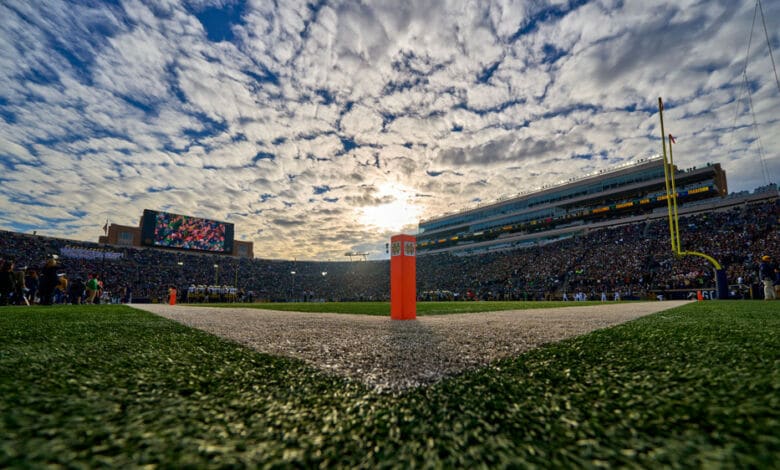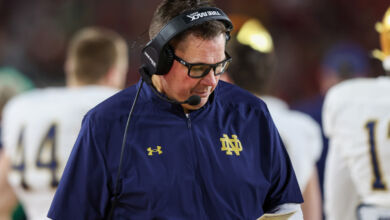
Let’s start with the preface that when talking about Notre Dame football independence, one currently discusses the level of independence and not absolute independence. Genuine, complete independence is a thing of the past, as 42% of Notre Dame’s football games are already being scheduled by the ACC with little to no say from Our Lady in the matter. However, suppose the Big 10 and SEC are successful in making themselves the Big 2 with all other conferences being largely irrelevant. In that case, Notre Dame will have little ability to simultaneously maintain both its football independence and relevance. I posit that Notre Dame is the only entity left with any power to stop the seemingly inevitable trek toward two mega-conference systems. But what will it decide?
As Notre Dame is currently a member of the ACC for Olympic sports and a partial member for football in that it plays five games in the ACC, the ACC is clearly the conference with which it is more closely aligned and the conference Notre Dame AD Jack Swarbrick thought preferable over the Big Ten or the SEC. The SEC is not a cultural or academic fit for Notre Dame, and the Big Ten just feels wrong on many levels.
The ACC, in terms of academics, culture, and feel, is a much better fit for the Fighting Irish. Additionally, the ACC provides a much more fertile recruiting ground for football as the ACC territory from Virginia through the Carolinas, Georgia, and Florida is very important and talent-rich. So, while the Big Ten is certainly the conference seen as the most likely landing spot for Notre Dame given the recent changes, there is an argument to be made for the benefits and viability of making the ACC its home.
Building up the ACC into a heavyweight conference would be considerably easier than doing likewise in the Big 12 or Pac 12. The ACC has won three of the last nine football National Championships. By comparison, the Big 10 has won only one National Championship during that time. The ACC has a true power program in Clemson and others that are certainly very capable of becoming so, including Miami and Florida State. When performing at or near potential, a top four teams of Miami, under Cristobal, a resurgent Florida State, Clemson, and Notre Dame is nothing to sneeze at, and a conference that simply could not be ignored as the Big 12 or Pac 12 may be. But how might Notre Dame prevent a two mega-conference system while preserving as much independence and self-determination as possible?
First, I start with the suspicion that Jack Swarbrick might not mind the Fighting Irish entering the ACC as full members. He started them on this path as members for the Olympic sports, with five of the twelve football games scheduled by the ACC. He included in that deal (or agreed to include) that Notre Dame would have to join the ACC if it entered a conference before 2036, seemingly tilting the playing field in the direction of the ACC. The ACC has recently decided to go to a 3-5-5 scheduling system for football. As ACC commissioner Jim Phillips’s #1 priority is to get Notre Dame into the ACC, it is tough to believe that the switch to a 3-5-5 scheduling system was not at least run past Jack Swarbrick for his thoughts.
Let’s look at what this scheduling system might mean to the Fighting Irish should they eventually join the ACC. The 3-5-5 system means that each team plays the same three opponents yearly and five rotating opponents. There are no divisions. And herein lies the opportunity for Notre Dame and the ACC should one agree that joining a conference is now inevitable and that maintaining three major power conferences is preferable and would preserve more independence for Notre Dame than in a two mega-conference world: Notre Dame could influence the teams that enter with it.
One potential scenario might include Notre Dame agreeing to enter the ACC fully on the condition that both Navy and Stanford also join. Navy is far more marketable and profitable than many people give them credit for being. That they currently have their own TV deal with CBS sports speaks to that. They have an established brand and are a fit in terms of academics and geography. They would provide a school in Maryland, a state in which the ACC currently does not have a school. Stanford has a recent history of football success, outstanding academics, massive resources, and an established identity and brand that is highly respected. Stanford also provides access to a west coast media market that would only enhance the ACC’s media deal. With the loss of USC and UCLA from the PAC-12, Stanford must be looking for an opportunity.
While Notre Dame would be entering the ACC fully and responsible for eight ACC football games per year, they would presumably have Navy and Stanford as two of their three-yearly opponents. So, while they would be adding three ACC games to their current five, two of them would be against opponents they would have been playing outside of the ACC had the three not joined together. Therefore, two of Notre Dame’s yearly non-conference opponents would become two of their annual conference opponents. Pittsburgh, Boston College, Miami, Florida State, and Georgia Tech are current ACC schools with which Notre Dame has had extensive rivalries or histories with that would serve as the third yearly opponent for Notre Dame. Notre Dame would continue their Navy and Stanford yearly contests perpetually and maintain four other non-ACC games to schedule whomever they’d prefer.
Along with these three schools joining the ACC, a fourth would probably be added from the west coast. Oregon would be the biggest prize, followed by Washington and others. This would bring the ACC to 18 members and with the type of power, money, and clout to remain a permanent survivor along with the SEC and Big Ten in the Game of Thrones saga currently playing out in college sports. This would prevent the Big Ten and SEC from monopolizing all college football money and relevance, would preserve as much independence as possible for Notre Dame, help Notre Dame athletics financially and provide a guaranteed path to the playoffs long-term.
So, while the Big Ten might be the odds-on favorite to land Notre Dame eventually, the ACC option is one worthy of Jack Swarbrick’s exploring. What is ultimately decided will soon be seen. While the fate of the ACC is still up in the air, too much has transpired to think the Pac-12 or Big-12 will remain as viable, competitive alternatives to the Big Ten and SEC. The schools remaining in those conferences with aspirations of big-time athletics will need to make a move to one of the new power conferences, and time is certainly of the essence. Whether their choices will consist of three power conferences or be limited to two power conferences remains to be seen. However, it appears that the University of Notre Dame might be the single entity possessing the power to make that determination.





This is great stuff.
The buzz and media are swirling around the idea that the best remaining Pac12 schools will inevitably be swallowed by the B1G or BigXII. With good reason – Oregon and others are terrified of a future where they are relegated to 2nd tier media deals and ultimately become less competitive. If they stay in the Pac 12 that is exactly what happens.
But there might be a better path to relevance and it aligns with Notre Dame’s goals. Strengthen the ACC and create a 3rd power conference that rivals the SEC/Big Ten for media dollars. Notre Dame is hungry to maintain a system outside two power conferences. NBC and CBS are hungry for a relevant college football property. ACC and Pac12 schools are hungry to maintain relevance, noting that the ACC schools are tied within GOR.
Here are the schools the ACC should consider adding to get to 20 teams:
Oregon
Washington
Stanford
Arizona
Colorado
The Seattle / Phoenix / Denver / Portland markets are large and the brands are worthy. Also note that these additions handicap future SEC/Big Ten expansion beyond the current 16 teams. The Big 10 could only add AAU schools Utah and Cal. The SEC might pick up Arizona State and Oklahoma State (from the Big XII). But their paths to 20 are no longer additive. This cements the new ACC as a relevant player going forward rather than waiting to see if Clemson or FSU just break to the SEC and let the rest play out in court.
really no Utah on your list
acc football is horrible. i rather have no part of it.
Understand your point, but if Swarbrick is mulling over Big 10 versus ACC, we’re lost. ACC is on it’s way out the door. Miami, FSU and Clemson are as good as gone to the SEC. Going to the ACC and bringing Navy and Stanford with ND? No way in hell. That’s the type of backwards thinking we surely don’t need. Pitt and BC and GT? Who cares anymore.
Wisconsin can replace Stanford, Iowa can replace Navy, Penn State can replace Pitt and games with even a Nebraska or Minnesota move the needle more than BC. Hell, I’d rather play Purdue/Indiana/Northwestern over junk like Georgia Tech or Duke or the shell that is VT.
As Keith said, it’s Big 10 or Independence. That’s it.
This article was written by a fantasy football nerd, not someone who understands the BUSINESS of college athletics. Which conference is more powerful on the field is irrelevant. That’s cyclical.
For the B1G, it’s about expanding the conference’s TV value.
For ND, it’s about academic fit, a secured future, and TV revenue. The ACC has an uncertain future., and ND belongs in the SEC like the Houston Rockets belong in the NHL.
In their next contract, the B1G is expected to net anywhere from $100-120 million annually, PER SCHOOL. ND gets $15 Million now from NBC. And for all those who would say it’s not about the money, and that it’s about tradition, those traditions will certainly suffer long-term if ND’s revenue is dwarfed by the likes of RUTGERS.
ND and the B1G have been overdue to hook up for decades. Now, the B1G has a more solid future, growing revenue, and is coast to coast with nearly all ND’s rivals, with Stanford on deck. ND is running out of reasons to not join the B1G.
ND has a $14 billion endowment so $80-100 million a year is not going to impact athletics, campus improvements, academic expansion, or student scholarships. Duke also has $12 billion in the bank. Why sell soul for some low class country club membership that are the SEC and B1G?
Money speaks. ACC is out of the question, unless Notre Dame is okay becoming the 3rd best football program in Indiana.
Miami and Florida State will be leaving the ACC soon, probably announcing their intentions next year. Those two teams moving out will start the dismantling of the ACC as Carolina would jump next. The TV money that the SEC and Big Ten teams will earn will be about $50 Million more than any ACC team will get. The ACC is a no win situation. Accept reality ND and join the Big Ten.
Miami and Florida State will not be leaving the conference next year. Why didn’t they leave the conference when both Texas and OU joined the SEC? Maybe its the fact that the SEC does not want Miami or Florida St. Miami and Florida St. does not add to a TV contract for the SEC. The networks are driving realignment. The grant of rights for all of the members in the ACC makes it very prohibitive financially for them to leave. It would cost member schools hundreds of millions of dollars to leave. There would be no advantage for these schools competitively to leave. Notre Dame’s position is still strong in the landscape of college football. Swarbrick’s relationship with Greg Sankey is strong. The football program is very profitable. And most of the ACC programs want to stay. It would take at least 7 schools that want to leave the ACC in order for the ACC to dissolve.
“The SEC is not a cultural or academic fit for Notre Dame, and the Big Ten just feels wrong on many levels.”
This is simply an empty comment. The Big Ten IS a cultural, geographical, traditional and academic fit for Notre Dame. Given the current sea change in college football, It feels right on many levels.
If Notre Dame is going to join a conference they need to join a conference that is booming—not a conference that needs to be saved from irrelevancy.
I say it’s B1G or maintain independence. The ACC is a defection or two away from being the Big 12 or the PAC12. Don’t join the ships that are sinking. Join the ship that just reinforced its hull
Good plan. The ACC has some trendy teams that will go in the up direction and play exciting ball. ND can bring in some West Coast teams. Maybe the TV revenue will be renegotiated. ND stands out in the ACC and will make it a very competitive league. More interesting. ND looks like a good fit.
The ACC is still relevant. Clemson has won national titles, Miami has won national titles, Florida State has won national titles. I recognize that the money is the reflection of the conference booming. However, they asked Notre Dame to join. That indicates Notre Dame’s position in the landscape of college football. They are still respected. Relationships with the Playoff committee is still strong. Meetings will happen in August. Notre Dame has had play based access to the CFP series since its inception. The TV contract with the ACC members and ESPN is strong for the next 12 years. It is very difficult for the ACC schools to get out. The SEC is not looking add. Notre Dame is highly profitable, and could make millions more in the next few years regardless of network. Only one B1G school have won titles in the last 20 years. Notre Dame will be fine regardless. I think that Notre Dame will jump into a conference in 12 years.
Why is this only a football only conversation? Does anyone anywhere want to watch an SEC basketball game compared to Duke vs. UNC or ND vs. BC? Look at the Learfield Director’s Cup standings and you’ll see the ACC is doing just fine in the majority of sports.